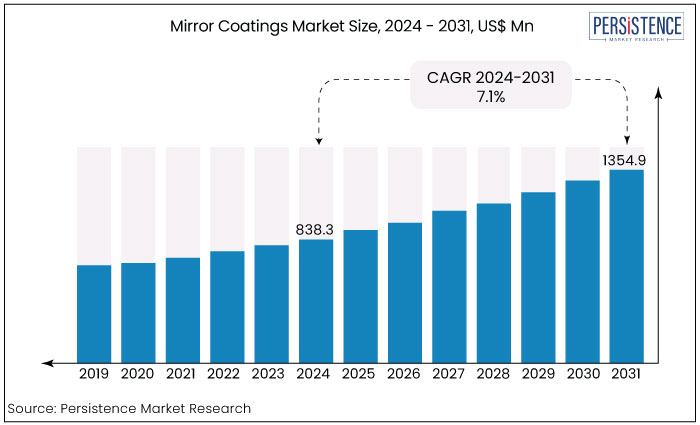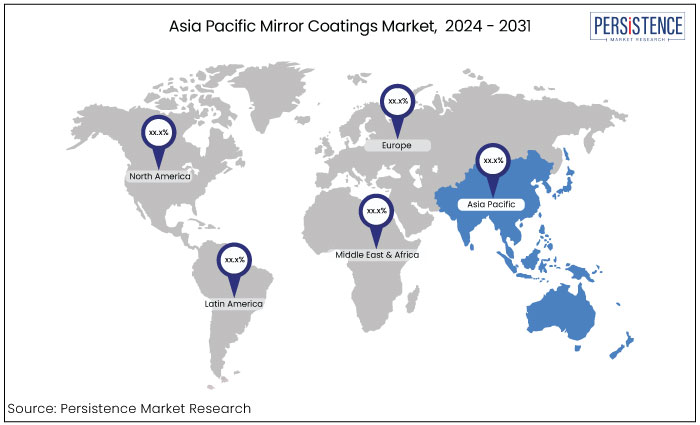Industry: Chemicals and Materials
Published Date: October-2024
Format: PPT*, PDF, EXCEL
Delivery Timelines: Contact Sales
Number of Pages: 160
Report ID: PMRREP34840
The mirror coatings market is estimated to increase from US$838.3 Mn in 2024 to US$1354.9 Mn by 2031. The market is projected to record a CAGR of 7.1% during the forecast period from 2024 to 2031. In the architectural sector, the trend toward energy efficiency and sustainable building designs is fueling demand for mirror coatings in windows and façades.

Key Highlights of the Market
|
Market Attributes |
Key Insights |
|
Mirror Coatings Market Size (2024E) |
US$838.3 Mn |
|
Projected Market Value (2031F) |
US$1354.9 Mn |
|
Global Market Growth Rate (CAGR 2024 to 2031) |
7.1% |
|
Historical Market Growth Rate (CAGR 2019 to 2023) |
6.5% |
Asia Pacific mirror coatings market is expected to grow significantly due to the escalating demand from the construction and infrastructure development sectors. Emerging economies like China, India, and various Southeast Asian nations are projected to invest significantly in infrastructure transformation during the forecast period.
With over 60% of the global population residing in this region, the increasing purchasing power and improved living standards over the past few decades are driving increased demand for new residential and commercial buildings, as well as other infrastructure projects. Consequently, mirror coatings are expected to flourish given their widespread application in the construction industry, further fueling market expansion.

North America automobile industry is anticipated to experience substantial growth driving demand for mirror coatings in the region. In recent years, electric vehicle (EV) sales in the United States have surged, a trend that is expected to persist throughout the forecast period. As consumer and commercial segments increasingly embrace electric vehicles, the automotive sector will continue to expand.
The construction industry in North America is projected to see significant growth due to heightened investments from both government and private sectors. Notably, in April 2024, the Biden administration unveiled a sweeping US$ 2.3 trillion infrastructure plan aimed at rebuilding and enhancing the nation’s infrastructure. This rising demand across the commercial construction and automotive sectors is poised to significantly propel the mirror coatings market forward.
The polyurethane segment holds a significant share of the mirror coatings market primarily due to its exceptional protective properties. A polyurethane coating involves applying a layer of polyurethane onto a substrate, providing defense against corrosion, abrasion, weathering, and various degrading factors.
Polyurethane offers unique characteristics that make it particularly suitable for specific applications while it may resemble other types of coatings. Its superior durability and flexibility sets it apart from alternative resins, allowing for enhanced performance in challenging environments. One of the standout advantages of polyurethane coatings is their remarkable longevity making them a preferred choice for industries requiring reliable and resilient protective solutions.
The architectural segment accounts for the significant share of the mirror coatings market, significantly contributing to its growth. As the building and construction industry expands, the demand for mirror coatings is expected to rise correspondingly. Mirrors are widely used in various architectural settings, including restaurants, bars, hotels, beauty salons, elevators, gyms, and washrooms.
In response to this increased demand, manufacturers of mirror coatings are enhancing their production capabilities and focusing on tailoring their products to meet the diverse preferences of end-users across different regions. This customization is essential, as demands can vary significantly based on local trends and individual tastes, driving further innovation within the market.
Mirror coatings refer to a type of thin film applied to glass or plastic substrates to create reflective surfaces that enhance the performance and aesthetics of mirrors. These coatings can be made from various materials including metals like aluminum and silver and dielectric substances. They are used to enhance visibility and energy efficiency.
The sector is currently experiencing significant growth driven by technological advancements and rising demand across multiple sectors. One of the most notable mirror coatings market trends is the increasing adoption of eco-friendly and energy-efficient coatings as manufacturers seek to reduce their environmental footprint. This shift is particularly relevant in the automotive and construction industries, where sustainability is becoming a priority.
The rise of smart mirrors, integrating digital technologies such as touch screens and augmented reality, is reshaping the market landscape. The demand for high-performance coatings that provide enhanced durability, scratch resistance, and improved optical properties is also rising. Furthermore, emerging markets in Asia Pacific are witnessing accelerated growth due to urbanization and increased construction activities.
The mirror coatings market analysis has highlighted a steady growth rate over the past few years with a CAGR of 6.5% from 2019 to 2023. This growth can be attributed to the increasing demand for reflective surfaces in various applications, including automotive, architectural, and consumer electronics. The rise in construction activities and the growing emphasis on energy-efficient solutions have further fueled this expansion.
The market is projected to accelerate, with an expected CAGR of 7.1% from 2024 to 2031. Several factors, including the ongoing innovation in coating technologies, the rising popularity of smart mirrors, and the increasing focus on sustainability, drive this anticipated growth. As industries continue to prioritize eco-friendly products, the demand for advanced mirror coatings that offer enhanced performance and durability is likely to rise.
Emerging markets particularly in Asia Pacific region, are expected to contribute significantly to this growth driven by urbanization and infrastructure development. Several trends and factors are fueling the industry growth opening several market opportunities.
Rising Demand in Construction and Automotive Industries
The increasing need for reflective surfaces in the construction and automotive sectors significantly drives mirror coatings market demand. In construction, reflective glass is utilized for its aesthetic appeal and energy efficiency helping to reduce heat absorption in buildings.
In the automotive industry, mirror coatings enhance visibility and safety by providing clear reflections. As urbanization continues and infrastructure projects expand, the need for high-quality mirror coatings is expected to grow further propelling market expansion.
Technological Advancements in Coating Materials
Innovations in coating technologies are a key growth driver for the mirror coatings market expansion. The development of advanced materials such as dielectric coatings and nanotechnology-based solutions has improved the performance characteristics of mirror coatings. It offers superior durability, scratch resistance, and optical clarity. These advancements enable manufacturers to produce coatings that meet the evolving demands of various applications. As technology continues to evolve, the market is expected to see increased adoption of these high-performance coatings.
Growing Focus on Sustainability
The increasing focus on sustainability and eco-friendly products is another key driver for the mirror coatings market growth. Consumers and industries are becoming more aware of their environmental impact, which leads to a demand for effective and environmentally friendly coatings.
Manufacturers are responding to this trend by developing coatings with reduced energy consumption and sustainable materials. This trend is particularly prominent in the construction and automotive sectors, where energy-efficient solutions are prioritized, thereby driving the growth of the industry.
High Production Costs
One of the significant factors impeding the growth of the mirror coatings market is the high production costs associated with advanced coating technologies. The materials used for high-performance coatings, such as metals and specialized polymers, can be expensive.
The manufacturing processes often require sophisticated equipment and technology, which further increases operational costs. These high expenses can deter small manufacturers from entering the market and may lead to higher prices for end consumers, ultimately limiting market expansion and adoption in cost-sensitive industries.
Competition from Alternative Technologies
The mirror coatings market faces stiff competition from alternative technologies that offer similar functionalities. For instance, advancements in digital display technologies such as LCD and OLED screens are providing consumers with alternatives to traditional mirrors. These technologies can offer enhanced features, such as adjustable brightness and integrated smart functionalities, which demand more to tech-savvy consumers. As these alternatives gain traction, they could reduce the demand for conventional mirror coatings posing a challenge to industry growth and innovation in the coatings sector.
Extensive Use in Renewable Energy Applications
One of the promising future opportunities for the mirror coatings market expansion lies in the growing adoption of renewable energy technologies, particularly solar energy. Enhanced reflective coatings are essential in solar thermal systems and photovoltaic panels, as they improve efficiency by maximizing light absorption and minimizing energy loss.
As the global demand for clean energy sources increases, the need for high-performance mirror coatings in solar applications is expected to rise. This trend presents a significant growth opportunity for manufacturers to innovate and cater to the renewable energy sector.
Development of Smart Mirror Technologies
The rise of smart mirror technologies represents a compelling future opportunity for the mirror coatings market concentration. Smart mirrors, equipped with advanced features like touchscreens, augmented reality, and integrated smart home capabilities, are gaining popularity in both residential and commercial sectors.
As consumer interest in connected devices continues to grow, the demand for specialized coatings that enhance the functionality and aesthetics of these smart mirrors will increase. Manufacturers can leverage this trend by developing innovative coatings that support the integration of digital technology while maintaining high optical performance.
The mirror coatings market is characterized by intense competition among key players striving for innovation and market share. Companies use several strategies such as developing new products, expanding their presence across regions collaborating with market players, and investing in research and development.
Companies like Guardian Glass have made significant strides by launching advanced reflective coatings since 2022, such as their EcoGuard series, which enhances energy efficiency in architectural applications. This innovation reflects a broad trend toward sustainability and enhanced performance positioning these companies to capitalize on the growing demand for high-quality mirror coatings across various industries.
Recent Developments in the Mirror Coatings Market
|
Attributes |
Details |
|
Forecast Period |
2024 to 2031 |
|
Historical Data Available for |
2019 to 2023 |
|
Market Analysis |
US$ Million for Value |
|
Key Regions Covered |
|
|
Key Market Segments Covered |
|
|
Key Companies Profiled |
|
|
Report Coverage |
|
|
Customization & Pricing |
Available upon request |
By Resin Type
By End-use
By Region
To know more about delivery timeline for this report Contact Sales

The market is predicted to rise from US$838.3 Mn in 2024 to US$1354.9 Mn by 2031.
A few of the leading key players in the market are Sherwin-Williams Company, Casix, Fenzi, JENOPTIK AG, and Dynasil Corporation.
Polyurethane is the leading resin type and it holds a significant share of the global market.
Asia Pacific is the leading region and is expected to grow significantly in 2024.
A key opportunity lies in the development of smart mirror technologies.